Malta Command
Malta Command was an independent command of the British Army. It commanded all army units involved in the defence of Malta. Once mobilised the Command deployed its headquarters to underground hardened shelters[1] and its combat units were deployed to fixed points in the Maltese countryside, from where they operated from. This mobilised, but largely static army garrison would be tested by aerial bombardment and naval blockade during the Second World War.[2] Whilst Malta Command was already a functioning command structure before 1939, it had existed in the Great War and was specifically mentioned in a House of Commons debate of 12 February 1917; the Second World War would see the Command operate as a genuine war-fighting headquarters,[3] albeit in a static defensive role.
| Malta Command | |
|---|---|
 Malta Command's Insignia and Shoulder Flash. | |
| Founded | 1915 |
| Disbanded | 1977 |
| Service branches | Operations, Plans, Intelligence, Logistics, Communications and Medical |
| Headquarters | Valletta, Malta |
| Manpower | |
| Conscription | Regular British and Maltese Army |
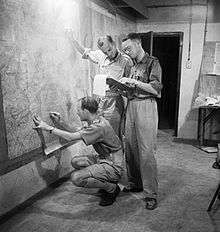
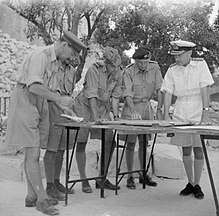


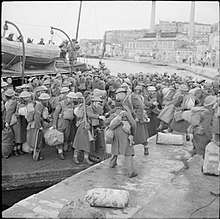
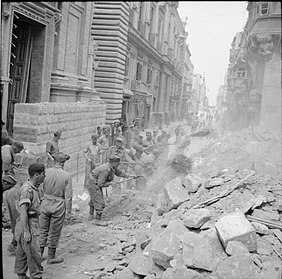
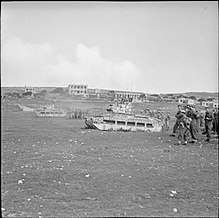
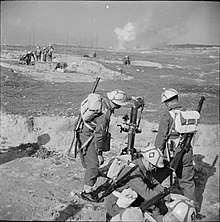

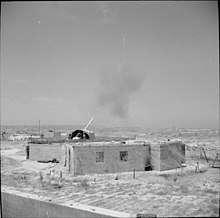
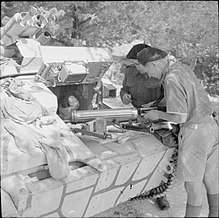
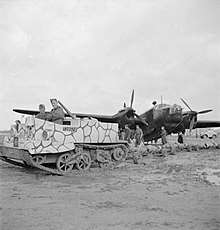
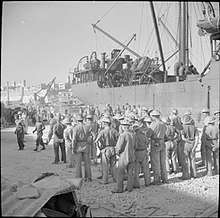
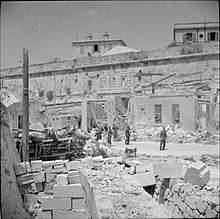

On 15 April 1942 the Island of Malta was awarded the George Cross by King George VI in recognition of the stalwart defence and fortitude of service personnel and civilians against a much more powerful Axis foe. Malta an Island of only 117 square miles had been more heavily bombed than London had been during their blitz.[4]
World War 1 and the Interwar Years
There is evidence that Malta Command existed in 1916,[5] 1917[6] and in 1929.[7]
Between 1935 and 1936 the following infantry battalions were on the Island and part of Malta Command:[8]
- 2nd Battalion The Lincolnshire Regiment
- 2nd Battalion The Rifle Brigade
- 1st Battalion The King's Own Scottish Borderers.
1939 - the Peacetime Garrison Transitions to War[9]
Malta's garrison was a single infantry brigade; comprising the 2nd Battalion the Devonshire Regiment, 2nd Battalion the Queen's Own Royal West Kent Regiment, 1st Battalion the Dorsetshire Regiment and the 2nd Battalion the Royal Irish Fusiliers. An infantry territorial unit was also present, the 1st Battalion The King's Own Malta Regiment. The Malta garrison's artillery was largely fixed and consisted of light and heavy anti-aircraft; and coastal defence artillery regiments drawn from the Royal Artillery (RA) and Royal Malta Artillery (RMA). The Royal Engineers were also in evidence with British and Maltese serving in the Corps on the Island.[10][11]
The Reinforced Army Garrison
On 11 March 1942 Malta Command became subordinate to General Headquarters (GHQ) Middle East.[12]
Infantry
In late 1939 the pre-war garrison was reinforced up to an infantry division (commanded by Major General Sir Sanford John Palairet Scobell).[13] The original infantry garrison, plus the three brigades that reinforced the island's regular British Army were titled 1, 2, 3, and 4 Brigades; but were subsequently renumbered in 1943 as follows:[14]
- 231 Infantry Brigade – assigned to the Southern Sector under Brig L H Cox. HQ Southern Infantry Brigade at Luqa. Its infantry battalions were:
- 2nd Battalion The Devonshire Regiment
- 1st Battalion The Hampshire Regiment
- 1st Battalion The Dorsetshire Regiment
- 2nd Battalion The King’s Own Malta Regiment
- 3rd Battalion The King’s Own Malta Regiment
- 232 Infantry Brigade – assigned to the Northern Sector under Brig W H Oxley. HQ Northern Infantry Brigade at Melita Hotel Attard next to San Anton Gardens. Its infantry battalions were:
- 2nd Battalion, Royal Irish Fusiliers
- 8th Battalion, King's Own Royal Regiment (Lancaster)
- 8th Battalion, Manchester Regiment[15]
- 233 Infantry Brigade – formed on 30 July 1941; assigned to the Central Sector under Brig I De La Bere. Its infantry battalions were:
- 11th Battalion The Lancashire Fusiliers
- 2nd Battalion The Queen’s Own Royal West Kent Regiment[16]
- 10th Battalion The King’s Own Malta Regiment
- 234 Infantry Brigade – assigned to the Western sector under Brig F Brittorous. Its infantry battalions were:
- 4th Battalion The Royal East Kent Regiment (The Buffs)
- 1st Battalion The Durham Light Infantry
- 1st Battalion The Cheshire Regiment
Light Support Weapons
| Name | Type | Photo | Numbers on Island & Remarks |
|---|---|---|---|
| Two-inch mortar | Light infantry mortar |  |
Each infantry battalion had 3 tubes per fighting platoon - circa 30 |
| . 55-inch Boys anti-tank rifle | Platoon anti-tank weapon |  |
Each infantry battalion had one per fighting platoon - circa 10. It was not a popular weapon to fire because of its extreme recoil and German tank armour was too difficult to penetrate, it was phased out in favour of weapons like the PIAT |
| .303 Lewis Light Machine Gun (LMG) | Platoon fire support weapon | 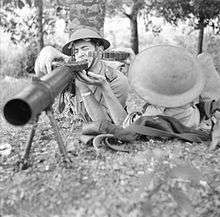 |
Some infantry battalion (e.g. KOMR) had Lewis Guns in lieu of Bren LMGs. This was a WW1 design weapon but highly regarded because of the gun's magazine capacity and rate of fire |
| .303 Bren LMG | Platoon fire support weapon | 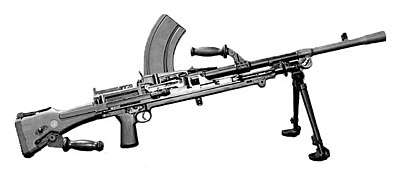 |
Each infantry battalion had three per fighting platoon and on other fire support vehicles - circa 40 |
Personal weapons such as the .303-in SMLE, 9mm Sten or .38 service revolver are not included in this study.
Artillery
- The Island's regular Royal Artillery force component was like its Maltese counterpart performing a mainly fixed defence role, even wheeled artillery tended to occupy fixed positions to defend against a hostile landing at beaches:
- 4th Coast Regiment, RA made up of (a HQ Battery, 6th, 10th & 23rd Coast Batteries)
- 12th Field Regiment RA - initially equipped with 18 Pounder Field Guns, but later equipped with 25 Pounder Field Guns (the only real mobile artillery support for the infantry brigades).[17]
- 26th Defence Regiment, RA made up of (a HQ Battery, 15th/40th & 48th/71st Defence Batteries).
- The Royal Malta Artillery
- Headquarters, RMA
- 1st Coast Regiment, RMA composed of (a HQ Battery, 1st, 2nd, 3rd & 4th Heavy Batteries)
The anti-aircraft defence was understandably dense and British and Maltese anti-aircraft (AA) units were interwoven into the following ORBAT:[18]
|
|
Heavy Support Weapons
By 1940 Malta Command had a small amount of modern mobile field artillery, much of its artillery was located in fixed positions in the anti-aircraft and coastal defence royal. It was manned by members of the Royal Artillery and Royal Malta Artillery.
| Name | Type | Photo | Numbers on Island and Remarks |
|---|---|---|---|
| .303 Vickers Heavy Machine Gun | Battalion fire support weapon | 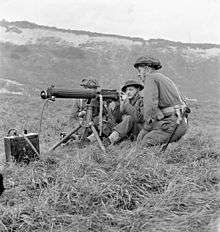 |
Each infantry battalion had four guns normally in a single Machine Gun Platoon |
| 3 Inch Mortar | Infantry mortar - battalion indirect fire support | 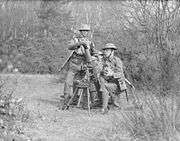 |
Each infantry battalion had 6 mortar tubes[19] |
| 2 Pounder Gun | Infantry anti-tank weapon | 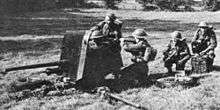 |
Each infantry battalion had two carried portee or dismounted in a 15cwt truck |
| 18 Pounder Field gun/Howitzer | Multi-role mobile field artillery | 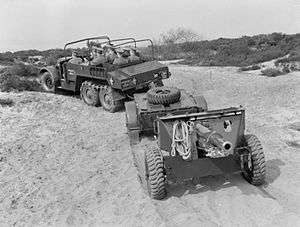 |
One RA coastal defence regiment of 24 guns |
| 25 Pounder Field gun/Howitzer | Multi-role mobile field artillery |  |
One RA field regiment of 24 guns |
For details of fixed artillery see Royal Malta Artillery's equipment list.
Royal Armoured Corps
- Malta Tanks (Royal Tank Regiment) - less than a full battalion of various reconnaissance and infantry support tanks.
Armour on Island
By 1942 Malta Command Tanks had a small mixed force of Royal Tank Regiment tanks known as "Malta Tanks" during its time on the Island. The only other armoured vehicles were the Universal Carriers of the infantry units.[20]
| Name | Type | Photo | Armament & Numbers on Island |
|---|---|---|---|
| Vickers Light Tank (Marks VIb&c) | Reconnaissance Tank | 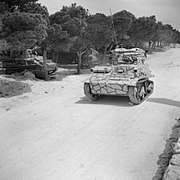 |
Dual turret fit of a Vickers .5in and .303 or Dual turret fit of a Besa 15mm and 7.92 mm Machine Guns - Three Deployed |
| Matilda (Mark II) | Infantry Support Tank | 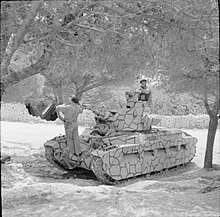 |
2 Pounder 40mm gun & Besa 7.92 mm coaxial machine gun - Four Deployed |
| Cruiser (Mark III or A13) | Cruiser Tank | 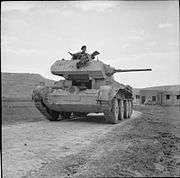 |
2 Pounder 40mm gun & Besa 7.92 mm coaxial machine gun - Eight Deployed |
| Valentine (Mark III) | Infantry Support Tank |  |
2 Pounder 40mm gun & Besa 7.92 mm coaxial machine gun - Four Deployed |
| Bren Gun Carrier | Lightly armoured tracked Infantry Weapons Carrier |  |
.55 Boys anti-tank rifle and/or .303 Bren Light Machine Gun - 10 deployed with each infantry battalion[21] |
Combat & Service Support Units[22]
|
|
|
Local Maltese Units (Regular and Territorial)
Critical to the success and resilience of Malta's was local commitment and bravery the following units were fully integrated in Malta Command:[24]
- The Royal Malta Artillery
- The King's Own Malta Regiment
- The Malta Fortress Squadron, Royal Engineers.
The War Draws to a Close and the Post War Period
On 2 December 1944 Malta Command regained its status as an independent command and it ceased its command relationship with GHQ Middle East in Cairo. The British would remember the war in a somewhat detached and romanticised fashion in films like The Malta Story; the Maltese never had a chance to record their views being viewed as 'plucky' citizens of a British colony. In 1954 Headquarters Malta Command occupied the Auberge de Castille, known locally as "The Castille".[25] Malta Command would be reduced from 1964 and this led to acrimony between the Maltese and British Governments, and the post independence period was a period of bitterness, British forces on the Island in the front line of Maltese antipathy. Malta Command was largely wound up by 1977 with all major units repatriated to the UK. Salerno Company of 41 Commando Royal Marines finally left the island aboard a Royal Fleet Auxiliary Sir Lancelot Landing Ship Logistic on 31 March 1979.[26]
See also
External links
References
- Weldon, H E C. (2016). Drama In Malta. Pickle Partners Publishing. ISBN 9781786258496. Retrieved 16 July 2017.
- "British Military History - Malta 1930 - 1945". www.britishmilitaryhistory.co.uk. Archived from the original on 15 July 2014. Retrieved 15 July 2017.
- "Votes of Credit Debate. (Hansard, 12 February 1917), Section 360". hansard.millbanksystems.com. Hansard. Retrieved 15 July 2017.
- "BBC - WW2 People's War - Battle For Malta (A Soldier's Story)". www.bbc.co.uk. BBC. Retrieved 17 July 2017.
- "THE HISTORY OF ANESTHESIA SOCIETY PROCEEDINGS" (PDF). 48. 2015: 79. Retrieved 17 July 2017. Cite journal requires
|journal=(help) - Light, Sue. "1-15 June 1917 - Scarlet Finders". www.scarletfinders.co.uk. Retrieved 17 July 2017.
- "Orders, Decorations, Medals and Militaria (1 December 2004) Serial 1477". www.dnw.co.uk. Dix Noonan. Retrieved 17 July 2017.
- Royal Lincolnshire and Royal Anglian Regimental, Association. "The Royal Lincolnshire and Royal Anglian Regimental Association". www.thelincolnshireregiment.org. Retrieved 17 July 2017.
- "History - The Land Forces". Malta at War Museum. Retrieved 15 July 2017.
- "History 2". Malta at War Museum. Retrieved 15 July 2017.
- "British Military History - Malta Command 1939" (PDF). Retrieved 16 July 2017.
- "GHQ Middle East". www.ordersofbattle.com. Retrieved 17 July 2017.
- "Malta Garrison 1940 - Infantry Brigades". maltaramc.com. Retrieved 16 July 2017.
- "Malta Command (1943)" (PDF). British Military History. Retrieved 16 July 2017.
- UK, National Archives. "Malta Command: Infantry: 8 Manchester Regiment". discovery.nationalarchives.gov.uk. Retrieved 17 July 2017.
- UK, National Archives. "Malta Command: Infantry: 2 Royal West Kent Regiment". discovery.nationalarchives.gov.uk. Retrieved 17 July 2017.
- Doherty, Richard (2016). Ubique: The Royal Artillery in the Second World War. History Press. ISBN 9780750979313. Retrieved 15 July 2017.
- "WO 373 Awards WO 373/78". www.hut-six.co.uk. Retrieved 17 July 2017.
- "British Infantry Battalion TO&E" (PDF). British Military Hospital. Retrieved 16 July 2017.
- "WWII Vehicles: The British Universal (or "Bren Gun") Carrier". warfarehistorynetwork.com. Retrieved 15 July 2017.
- "Universal Carrier". www.tanks-encyclopedia.com. Retrieved 15 July 2017.
- "WO 373 Awards WO 373/78". www.hut-six.co.uk. Retrieved 17 July 2017.
- "Malta Garrison 1946". maltaramc.com. Retrieved 17 July 2017.
- "Maltese Serving with the British Forces". www.iwm.org.uk. Imperial War Museum. Retrieved 17 July 2017.
- Richards, Brian (2008). "Malta". New Holland Publishers. Retrieved 18 July 2017.
- "Naval & Military - Salerno Company 41 CDO RM - Tal-Ħandaq Nostalgia". www.talhandaqnostalgia.org. Retrieved 18 July 2017.